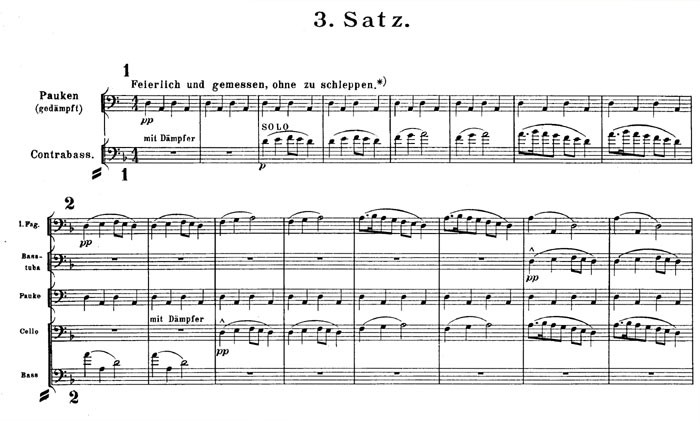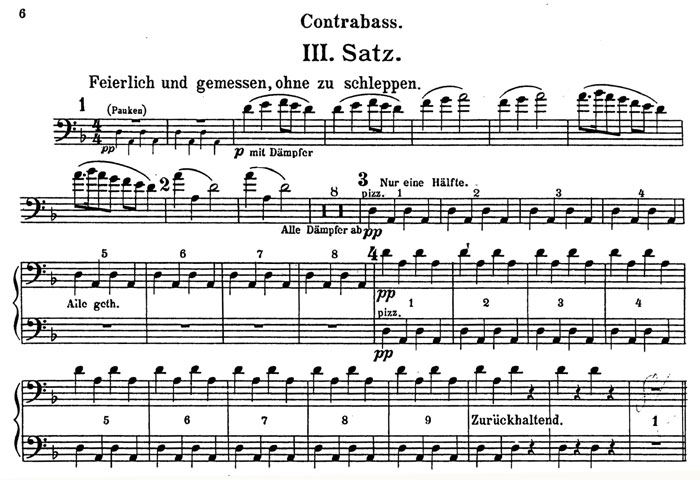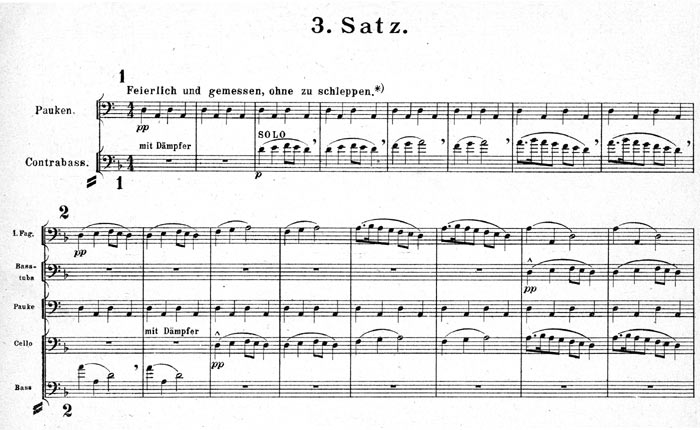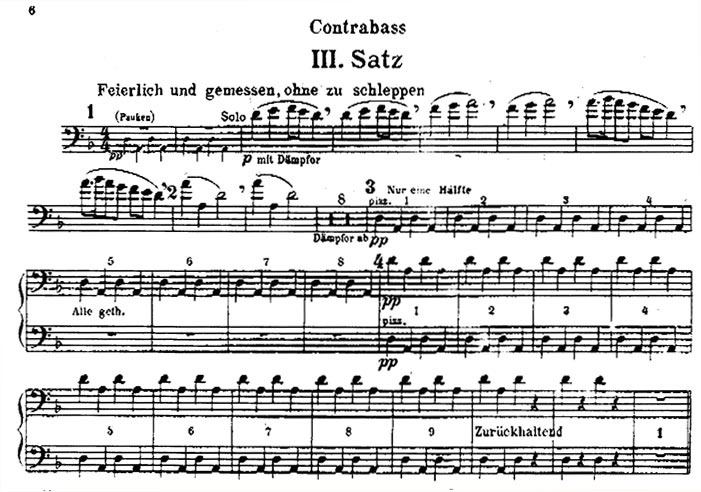
![Main heading: The Music of Gustav Mahler: A Catalogue of Manuscript and Printed Sources [rule] Paul Banks](../../images/General%20Heading3.jpg)
|
|
|||||||||||||
|
|
|||||||||||||
|
|
|||||||||||||
|
|
|||||||||||||
|
|
|||||||||||||
|
|
|||||||||||||
|
|
|||||||||||||
|
|
|
||||||||||||
|
|
|||||||||||||
|
|
|||||||||||||
|
|
|
||||||||||||
|
|
|||||||||||||
|
|
|||||||||||||
|
|
|||||||||||||
|
Index of Works |
|
||||||||||||
|
Site Map |
|
||||||||||||
|
|
|||||||||||||
|
|
|
||||||||||||
|
|
|||||||||||||
|
|
|
||||||||||||
|
|
|
||||||||||||
|
|||||||||||||
Symphony No. 1: the double bass solo revisited
One of the important features of Sander Wilkens’ editorial strategy in the Vebesserte Ausgabe of the First Symphony (SW1b) is the very careful examination of the printed part sets he has undertaken and as a result a number of orthographic errors have been corrected. But nowhere does Wilkens discuss the fact that Mahler’s printed parts (at least for the early symphonies) were rarely, if ever, copied from the Stichvorlage of the score, but were usually derived from some rather earlier manuscript part set. The collation of score and parts at the time of the first printings was not always exhaustive, with the result that the early printed parts to Mahler’s works sometimes preserve superseded readings: thus they be can of considerable interest in the study of Mahler's revision process, but have to be treated with extreme caution by editors of his music.
In the case of the First Symphony no manuscript parts survive, so the pre-publication history of the printed parts is uncertain. This fact may help to explain the most controversial aspect of the new edition: the assertion that the parts establish that the opening of the slow movement should not be played by a solo double bass, but by the whole section. Thus, according to Wilkens, the word ‘SOLO’ in the score refers to a solo to be played by the section (SW1b, xv; for clarity my additions in the quotations below are enclosed within curly brackets {}):
|
Der „Solo“-Vermerk der Kontabässe am Beginn des 3. Satzes ist Relikt mehrer Eingriffe und Anlaß eines Mißverständnisses. [A] {=AF2} verzeichnet „Celli“ und „Bässe“ jeweils vor Akkolade 1 und 2, T. 3 „Solo (mit Dämpfer)“, pp; Vc T. 11 „Tutti (mit Dämpfer)“; [K1] {=ACF1} korrigiert (autograph) zu „I. Kontrabaß“, „Dämpfer“ nachträglich, und streicht Vc T. 3-11 inklusive „Solo“ T. 11; [StV1] {=ACF4} wiederholt diese Version – 1. Kb. T.3–11 mit Dämpfer, Vc T. 11 tutti (Akkoladenzeichen durchgehend Singular wie [EA] {=PF1} bis auf Pauken). Die Tatsache, daß die Erstausgabe (der Partitur) im Akkoladenzeichen auf die Solo-Kennzeichnung (I. Kb) verzichtet und alle Kb-Pulte {in PO1} T. 3-11 ausdruckt, läßt nur den Schluß zu, daß Mahler sich mit [EA] {=PF1} zu dieser Version entschlossen hat, wobei die Stimmen die Vorlage bildenten und in keiner überlieferten Sammlung inkl. [St1] {=GMPO2} korrigiert erscheinen. Das verbliebene „Solo“ wandelt seine Bedeutung zu einem Gruppensolo im Unisono. |
The marking ‘SOLO’ in the double basses at the beginning of the 3rd movement is the remnant of several interventions and the cause of a misunderstanding. [A] {=AF2} specifies ‘Celli’ and ‘Basses’ for systems 1 and 2, (supplemented in) b. 3 by ‘Solo (mit Dämpfer)’, pp, (and in b. 11 of the cello part) with ‘Tutti (mit Dämpfer)’; [K1] {=ACF1} is corrected in autograph to ‘I.double bass’ supplemented by ‘Dämpfer’, and deletes bb. 3-11 in the cello part, including ‘Solo’ {recte ‘Tutti’?} in bar 11. [StV1] {=ACF4} reproduces this version – bb. 3–11 played by 1 double bass, with tutti cellos at b. 11 (apart from the timpani, the instrumental designations of the parts are in the singular as in the first edition {of the score}. The fact that the first edition {of the full score} dispenses with the solo marking (1. Db) in the system designation and that all the double bass parts {in PO1} reproduce bb. 3–11 leads to the conclusion that Mahler himself had decided on this version for the first edition, for which the parts (which are corrected in no surviving set, including [St1] {=GMPO2}) formed the model. The remaining ‘SOLO’ changed its meaning to that of a section solo in unison. |
As can been see in Figs 1 and 2 below, this description of the sources is accurate – as far as it goes¹ – and the conclusion is elegantly simple, but it leaves unmentioned some significant issues. The most obvious of all is why, if Mahler had decided that the passage should be played by all the double-basses, he retained the very prominent marking ‘SOLO’ in the first edition of the score. The use of the term ‘solo’ when applied to a section, to mean hevortretend or to indicate, as Schoenberg would later, Haupstimme, was by no means unknown in nineteenth century scores. But nowhere else in his output does Mahler use the term to mean a section solo and here it would be unnecessary anyway – even for the least competent conductor – and merely creates a potential source of confusion (as the necessity for this whole discussion reveals).

Fig. 1
Mahler, Symphony No. 1, full score, first edition (1898, PF1)

Fig. 2
Mahler, Symphony No. 1, double bass part, first edition (1899, PO1)
It is perhaps worth noting that there are other features in the orthography of the first editions of the score and parts that suggest that for some reason this was a passage that failed to receive the editorial attention it merited as it passed through the initial publication process. PF1 fails to indicate when the double bass player(s) should remove the mute(s), though the parts supply the instruction Alle Dämpfer ab at the end of b. 12 (see Fig. 1 and 2).² At first glance this instruction’s reference to Alle Dämpfer seems to support Wilkens’ argument, except that the use of Alle here seems to be superfluous: elsewhere (e.g. violas & cellos, b. 38) the instruction is simply Dämpfer ab.
Significantly SW1b omits to point out that all these issues were resolved by the second edition of the orchestral parts (PO2), but in a way that confirms what is now the universal performance practice: in the double bass parts bb. 3–11 are marked ‘Solo’ and the instruction beneath the 8 bars rest is simply ‘Dämpfer ab’ (see Figs 3 and 4 below). This would be an unequivocally conclusive piece of evidence against Wilken's reading were it not for the fact that the production of PO2 was delayed until after Mahler's death: the first violin part was printed only in 1912 and it was 1920 before the revised double bass part appeared. But whatever Universal Edition's in-house editing process took as its copy text – and APF6 seems the most likely candidate – it is noticeable that the passage clearly had attracted Mahler's attention, as he had added some additional articulation of the double bass solo, yet he was happy to retain the potentially ambiguous solo marking.³

Fig. 3
Mahler, Symphony No. 1, full score, second edition (1912, PF2)

Fig. 4
Mahler, Symphony No. 1, double bass part, second edition (1920, PO2)
More importantly, there is a strand of contextual evidence not discussed by Wilkens that provides insights into the expectations and actual experiences of contemporary audiences. Whatever the conflict between readings of the first editions of the score and parts, when early commentators and reviewers comment on the scoring of the passage at all, they are unanimous in indicating that what they expected to hear or did hear, was a solo double bass:
|
‘... Ein gedämpfter Contrabaß trägt das Thema vor ....’. Ferdinand Pfohl: review of Hamburg performance, 27.10.1893 conducted by Mahler, reprinted in FPGM 64–7 |
|
‘Gedämpfte Pauken beginnen ...; dazu singt ein gedämpfter Solo-Bass die klagende Weise’, Dresden concert programme note by Friedrich Brandes for the performance by Ernst von Schuch on 16. December 1898) |
|
‘Leise beginnt der Kontrabass das Thema ...’. Mahlers Symphonien, (Berlin: Schlesinger'sche Buch-und Musikhandlung, [ca. 1910?], 22. |
|
‘Ein Kontrabaß setzt ein, ...’ Paul Stefan in 1910 (PSGM1, 91). |
But the most compelling testimony concerns Mahler’s own practice: in his review in the Neues Wiener Tagblatt (319 (20 November 1900), p.2) of the first performance of the work in Vienna (i.e. after the publication of the score and parts), Max Kalbeck refers specifically to the use of a single double bass at the opening of the slow movement (I’m most grateful to Donald Mitchell for drawing this review to my attention). To this can be added the fact that in all seven of his recordings of the work, Bruno Walter (who made the piano duet transcription) gives the opening statement of the theme to a solo double bass. All of this provides strong evidence that what was awry here was not the score, but the first edition of the orchestral parts: for once a long-established performing tradition is correct.

![]() https://orcid.org/0000-0002-2258-0267
©
2007-21 Paul Banks | This page was lasted edited on
07 January 2021
https://orcid.org/0000-0002-2258-0267
©
2007-21 Paul Banks | This page was lasted edited on
07 January 2021